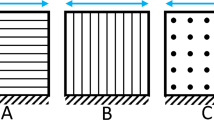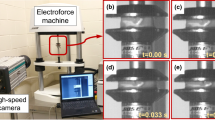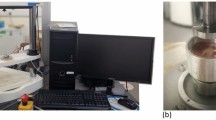Abstract
Computational models and physical surrogates can provide important insight into complex biomechanical loadings, such as those leading to mild Traumatic Brain Injury (mTBI). However, accurate material properties are required in order to fully realize the potential of such models. This study compares the material properties of porcine brain tissue with various surrogate materials (0.4%, 0.6%, 0.8% concentration agarose gelatin; 3%, 5%, 10% concentration bovine ballistic gelatin; and Sylgard 527). The quasi-static compression properties and dynamic viscoelastic properties (1–200 Hz) for each material were measured using a Dynamic Mechanical Analyzer (TA Instruments, DMA Q800). The tests were performed at room temperature, using fresh porcine brain tissue samples (less than 15 min post-mortem) obtained from a local abattoir. The quasi-static compression stress-strain curves of 5% concentration was in good agreement with the experimental data, while the remaining tissue surrogates were generally higher in stiffness. In terms of dynamic analysis, the complex modulus of the agar and Sylgard 527 materials were found to be comparable to the porcine brain tissue, while the bovine gelatin diverged at higher frequencies.
Access provided by Autonomous University of Puebla. Download conference paper PDF
Similar content being viewed by others
Keywords
8.1 Introduction
In many injurious conditions, such as mild Traumatic Brain Injury (mTBI), the complexity of the biomechanical loading creates challenges for researchers to understand and mitigate the mechanisms of injury. In such cases, computational models [1] and physical surrogates [2] may provide important insights to aid in understanding injury and developing protection systems. However, both of these are often limited by the biofidelity of the constitutive model or tissue simulant materials used to assess response. Thus, there is a need for accurate material properties of brain tissue to support computational modeling, as well as the identification of potential tissue simulants that can be used in physical test surrogates.
Previous studies in the literature have identified some common brain tissue simulants, most commonly gelatins (porcine and bovine) [3], hydrogels [4], and silicon elastomers [5]. This study measures the response of fresh porcine brain tissue and a variety of current tissue simulants in quasi-static compression and using Dynamic Mechanical Analysis (DMA).
8.2 Methods
The use of animal tissues in this study was approved by the University of Waterloo Office of Research Ethics (UW ORE: A-14-11), and all tissue handling and disposal was done in accordance with their guidelines. Fresh porcine brains were sourced from a local abattoir, and obtained within 15 min post-mortem. Tissue samples were prepared and tested within 4 h to prevent degradation of the tissue. The samples were mixed gray and white matter and were excised using a scalpel. In addition, three different tissue simulant materials were tested: bovine gelatin (at 3%, 5%, and 10% weight concentration), agarose gel (at 0.4%, 0.6%, and 0.8% weight concentration), and Sylgard 527. All tests were performed at room temperature (25 °C).
The materials testing was performed using a Dynamic Mechanical Analyzer (DMA, TA Instruments Q800). Each material was tested in quasi-static compression and dynamic sinusoidal compression. The quasi-static compression tests provided stress-strain data for each material. The dynamic tests provided storage and loss moduli over a range of frequencies (1–200 Hz).
8.3 Results
Both the brain tissue and the tissue simulants demonstrated a typical hyperelastic response to quasi-static compression (Fig. 8.1). The agar and bovine gels demonstrated increased stiffness with increased volume concentration. The agar gel also demonstrated a higher stiffness region at small strains, and exhibited a linear response at higher volume concentrations, which was not observed in the brain tissue.
The complex modulus of brain tissue was found to increase with frequency (Fig. 8.2), which is in agreement with the literature where brain tissue is known to be stiffer at higher strain rates [6]. The complex moduli of agar gels and Sylgard 527 were found to be in reasonable agreement with brain tissue, whereas the bovine gelatin demonstrated significantly greater values at frequencies exceeding 140 Hz.
8.4 Summary
The properties of fresh porcine brain tissue and three tissue simulants were measured in quasi-static compression and dynamic mechanical analysis. The compressive stress-strain response of 5% bovine gelatin was found to most closely match the response the brain tissue, while the agar gels and Sylgard 527 were observed to exhibit higher stiffness. With respect to dynamic response, the bovine gelatins were observed to have significantly greater complex moduli at higher frequencies, whereas the other simulants were comparable to the measured brain tissue response.
References
Ganpule, A., et al.: Mechanics of blast loading on the head models in the study of traumatic brain injury using experimental and computational approaches. Biomech. Model. Mechanobiol. 12(3), 511–531 (2013)
Downes, D., et al.: Development and validation of a biofidelic head form model to assess blast-induced traumatic brain injury. J. Def. Model. Simul. 15(3), 1–11 (2017)
Pervin, F., Chen, W.W.: Mechanically similar gel simulants for brain tissues. In: SEM, Indianapolis, 7–10 June 2010
Falland-Cheung, L., et al.: Elastic behavior of brain simulants in comparison to porcine brain tissue at different loading velocities. J. Mech. Behav. Biomed. Mater. 77, 609–615 (2018)
Bradshaw, D.R.S., et al.: Simulation of acute subdural hematoma and diffuse axonal injury in coronal head impact. J. Biomech. 34, 85–94 (2001)
Rashid, B., et al.: Mechanical characterization of brain tissue in tension at dynamic strain rates. J. Mech. Behav. Biomed. Mater. 33, 43–54 (2014)
Author information
Authors and Affiliations
Corresponding author
Editor information
Editors and Affiliations
Rights and permissions
Copyright information
© 2019 The Society for Experimental Mechanics, Inc.
About this paper
Cite this paper
Singh, D., Boakye-Yiadom, S., Cronin, D.S. (2019). Comparison of Porcine Brain Tissue with Potential Surrogate Materials Under Quasi-static Compression and Dynamic Mechanical Analysis. In: Arzoumanidis, A., Silberstein, M., Amirkhizi, A. (eds) Challenges in Mechanics of Time-Dependent Materials, Volume 2. Conference Proceedings of the Society for Experimental Mechanics Series. Springer, Cham. https://doi.org/10.1007/978-3-319-95053-2_8
Download citation
DOI: https://doi.org/10.1007/978-3-319-95053-2_8
Published:
Publisher Name: Springer, Cham
Print ISBN: 978-3-319-95052-5
Online ISBN: 978-3-319-95053-2
eBook Packages: EngineeringEngineering (R0)






